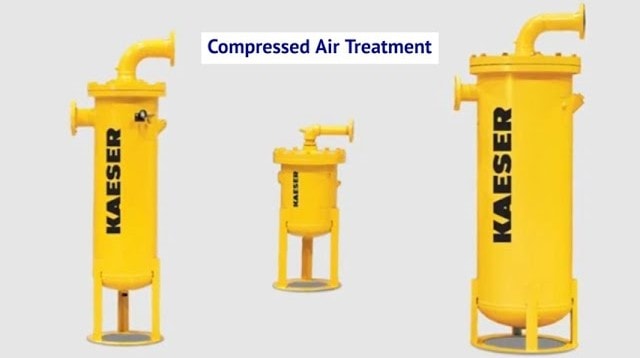Many industries depend on compressed air to quickly clean items, operate air-powered tools and equipment, and various other purposes. Compressed air treatment becomes necessary as contaminants accumulate in compressed air equipment under extended use or certain operating conditions. When unaddressed for extended periods, deposits of oil, water, and particulates can lead to broken equipment, costly downtime, and adverse health effects.
Here, we’ll discuss four general types of devices and procedures for removing compressed air contaminants.
Compressed Air Dryers
Water can condense in the air lines of compressed air systems for a number of reasons, including humid conditions, system cooling, and pressure drops. Compressed air dryers efficiently remove moisture from compressed air, reducing the risk of water condensing and entering the air lines, which can lead to corrosion, frozen lines, and other service issues.
There are two common types of compressed air dryers:
- Refrigerant dryers: These are more common and use refrigerant to cool air much like a refrigerator or air conditioner. They function by cooling air to a pressure dew point of about 33–39° at which point water vapors condense and separate from the air.
- Desiccant dryers: This type absorbs moisture from the air using a type of desiccant, like silica gel. While more costly, desiccant dryers are a superior option under certain applications.
Compressed Air Filters
Filters are the primary means of removing compressed air particulates. Solids such as dirt, oil, and dust are common in industrial settings, which easily find their way into compressed air equipment.
There are also two types of air filters for compressed air:
- Particulate filters: These filters typically use a paper or mesh filter to intercept particulates and other dry solids from compressed air.
- Oil mist filters: These filters are for removing oil and greasy residues. An oil mist filter functions using absorbent materials, such as activated carbon.
Condensate Management
As the air cools in the system, any moisture present in the lines will turn into condensate, which can easily damage air lines through freezing and corrosion. It’s a prevalent problem in climates with high humidity and a dynamic temperature range that frequently crosses the dew point threshold.
Condensate management is the process of removing condensate, for which there are a variety of methods:
- Condensate traps: These valves passively collect condensation as it accumulates and becomes heavier. The condensate can be drained after accumulation.
- Condensate manifolds: These devices vent high-pressure condensate lines. By diffusing residual air pressure, manifolds improve air/condensate separation, venting moist air safely out of the compressed air system.
- Oil/Water separators: These fulfill the crucial additional step of separating oil and water. This makes further compressed air treatment easier and simplifies the oil collection and disposal process. It also reduces wear on other condensate management systems that aren’t suitable for oils and residues.
- Aftercoolers: Aftercoolers are a type of heat exchanger that cools air as it enters a compressed air system, preventing moisture from forming in the first place.
Compressed Air Systems provides efficient condensate traps and aftercoolers for sufficient condensate management.
Air-Cooled and Water-Cooled Aftercoolers
By reducing the temperature of compressed air before it enters the system lines, aftercoolers prevent moisture from ever reaching the air lines. The cooling process occurs right after discharge, preventing a large amount of moisture from entering deeper into the compressed air system and causing damage.
Aftercoolers maintain cool, dry air and improve the efficiency of air-powered equipment. They also reduce the time, labor, and expense of removing moisture and repairing air lines and other components.
There are two types of aftercoolers, depending on your compressed air treatment needs:
- Air-cooled aftercoolers: These are the most common type of aftercooler. They cool compressed air using the ambient air.
- Water-cooled aftercoolers: Water-cooled aftercoolers are more efficient, as water stores more thermal energy than air. However, these aftercoolers require a water supply, resulting in a more complex and resource-intensive solution than the former option.
Compressed Air Treatment Products from BuyKaesar
While compressed air is a valuable resource in a variety of industrial settings, it’s most effective when the system is well-maintained and kept free of contaminants. That’s why selecting the right compressed air treatment for your needs is essential.
The fastest and most effective way to protect and optimize your compressed air system is to contact us. You can also request a quote for any of our advanced compressed air treatment products and discuss your particular compressed air treatment needs with Kaeser’s experienced compressor technicians.

